第7章 常用实用类
第7章_实用类

目 录
Date类
Calendar类
Math类
HashMap<K,V>泛型类
ArrayList <E>泛型类(略) LinkedList <E>泛型类 HashSet <E>泛型类
日期va.util.Date
封装了一个时间点 java.util.GregorianCalendar(由Calendar类派生) 提供了月历的功能,及很多与日期相关的方法 java.text.DateFormat 生成和解析日期和时间的字符串表示
将时间与日历分开是一种很好的面向对象设计 OCP
System类
public static native long currentTimeMillis(); 当前时间与协调世界时 1970 年 1 月 1 日午夜之间 的时间差(以毫秒为单位测量)。 public static native long nanoTime(); 系统计时器的当前值,以毫微秒为单位。
期的Date对象。
getTime()返回自
1970 年 1 月 1 日 00:00:00 GMT 以来此 Date 对象表示的毫秒数
toString()
toString() :dow mon dd hh:mm:ss zzz yyyy
dow 是一周中的某一天 (Sun, Mon, Tue, Wed, Thu, Fri, Sat)。 mon 是月份 (Jan, Feb, Mar, Apr, May, Jun, Jul, Aug, Sep, Oct, Nov, Dec)。 dd 是一月中的某一天(01 至 31),显示为两位十进制数。 hh 是一天中的小时(00 至 23),显示为两位十进制数。 mm 是小时中的分钟(00 至 59),显示为两位十进制数。 ss 是分钟中的秒数(00 至 61),显示为两位十进制数。 zzz 是时区(并可以反映夏令时)。标准时区缩写包括方法 parse 识别的时区缩写。如果不提供时区信息,则 zzz 为空, 即根本不包括任何字符。 yyyy 是年份,显示为 4 位十进制数
第7章-营业成本与存货
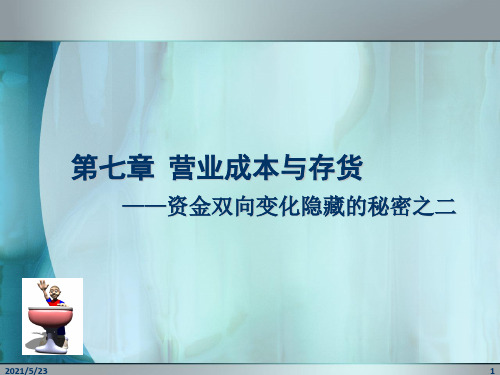
2021/5/23
2
学习目标
在本章中,你将学到: ➢ 不同类型的公司如何计算销售成本 ➢ 发出存货的计价方法 ➢ 不同的存货的计价方法对资产负债表和利润表产 生怎样的影响 ➢ 什么是存货,如何确认与计量存货,存货与销售 成本是何关系 ➢ 资产负债表中存货和利润表中的营业成本又向我 们揭示怎样的信息
这一方法用于制造业,称为“以存计耗”或“盘存计耗”;用于商 品流通企业,称为“以存计销”或“盘存计销”。 营业成本 = 期初存货成本 + 本期购入存货成本 – 期末存货成本
2021/5/23
10
营业成本的计量
2、永续盘存制 永续盘存制也称账面盘存制,指对存货项目设置经常性的库存记录,
即分别品名、规格设置存货明细账,逐笔或逐日地登记收入发出的存货, 并随时登记结存数。
已售存货的成本结转为当期损益,计入营业成本,即企业 在确认存货销售收入的当期,应当将已经销售存货的成本 结转为当期营业成本。
根据企业从事业务类型不同,公司常区分为: 商品流通企业、制造业企业和服务性企业等。
2021/5/23
5
商品流通企业
➢ 商品流通企业是从事批发、零售及分销等业务的经济 实体。 ➢ 商品流通企业的存货主要是购入以备出售的库存商品。 ➢ 利润表中的营业成本就是已实现销售的商品购置成本, 而未实现销售的商品购置成本则在资产负债表中的存货 项目列示。
第七章 营业成本与存货
——资金双向变化隐藏的秘密之二
2021/5/23
1
导入案例
2012年暑假,王红为了给自己积累更多的经济学方面感性认识, 也为了挣点零花钱,在社区服务社租了个摊点摆了个冰柜卖冷饮,主 要经营酸奶、雪碧、可乐、矿泉水和雪糕零售。
生产自动化操作实用指南

生产自动化操作实用指南第1章生产自动化概述 (4)1.1 自动化的发展历程 (4)1.2 自动化在制造业的应用 (4)1.3 生产自动化的优势与挑战 (4)第2章自动化系统的基本构成 (5)2.1 控制器与执行器 (5)2.1.1 控制器 (5)2.1.2 执行器 (5)2.2 传感器与检测技术 (5)2.2.1 传感器 (6)2.2.2 检测技术 (6)2.3 通信与网络技术 (6)2.3.1 通信技术 (6)2.3.2 网络技术 (6)2.4 人机界面与交互设计 (6)2.4.1 人机界面 (6)2.4.2 交互设计 (6)第3章自动化设备选型与安装 (6)3.1 设备选型原则与方法 (6)3.1.1 选型原则 (7)3.1.2 选型方法 (7)3.2 设备安装与调试 (7)3.2.1 设备安装 (7)3.2.2 设备调试 (7)3.3 设备维护与故障排除 (7)3.3.1 设备维护 (8)3.3.2 故障排除 (8)第4章控制系统设计 (8)4.1 控制系统概述 (8)4.1.1 控制系统的基本组成 (8)4.1.2 控制系统的类型 (8)4.1.3 控制系统的功能指标 (9)4.2 控制算法及其应用 (9)4.2.1 PID控制算法 (9)4.2.2 模糊控制算法 (9)4.2.3 神经网络控制算法 (9)4.2.4 鲁棒控制算法 (9)4.3 控制系统仿真与优化 (9)4.3.1 控制系统仿真 (9)4.3.2 控制系统优化 (9)第5章生产线布局与优化 (10)5.1.1 合理分区:根据生产流程,将生产线划分为加工区、装配区、检验区、仓储区等,实现生产过程的有序进行。
(10)5.1.2 最短路径:在布局设计中,尽量缩短物料和产品在生产线上的运输距离,降低物流成本,提高生产效率。
(10)5.1.3 保证安全:充分考虑生产过程中的人员、设备、物料安全,设置安全防护设施,避免潜在的安全隐患。
第七章 社区康复护理
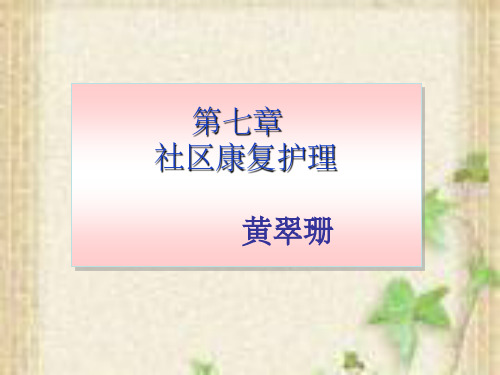
指生理、心理、人体结构上
及某种组织不同程度的功能
丧康复失护或理者的不措正施常帮,助造他成们部延分 或缓衰全老部,失提去高正生常活人质的量功。能或
失缓慢去进社程会和生反活复能发力作的,人不。断 加重脏器功能的障碍,功能 障碍又可能加重病情,形成 恶性循环。
实用文档
二、社区康复护理的对象与内容
(二)工作内容
实用文档
运动疗法
又称体育疗法,是借助于运动来使患者 调整身心、恢复健康和劳动能力的 一种方法。中国是世界上最早 应用运动疗法的国家。
据资料介绍,早在公元前771年,名 医扁鹊就开始采用体操和按摩来防治 疾病。此后,古印度、埃及、希腊和 罗马的医生们也相继借助于体育运动 来预防和治疗疾病。
实用文档
作业治疗
实用文档
bath蜡疗机(荷兰)
语言治疗
贫困家庭聋儿接受语言康复训练
实用文档
言语治疗仪
• 具有诊断、治疗、记 忆功能
• 适应症:喉返神经麻 痹、咽上壁麻痹、咽 部混合性麻痹、预防 和治疗构状软骨囊性 纤维化、面瘫、舌下 麻痹、咽下困难、神 经肌肉疲劳、神经肌 肉紧张、神经痛、感 觉不良和感觉异常造 成的障碍、离子电渗 疗法。
我国残疾人6000万 听力言语残疾2057万 智力残疾1182万 肢体残疾877万 视力残疾877万 精神残疾225万 多重残疾及其他残疾782万人
平均每5个家庭中就有一个家庭有 残疾人 ——有逐年增N 加的实用文趋o 档 势——
Image
第一节
概述
实用文档
一.社区康复护理的基本概念
(一)康复
• 本意“复原”、“重新获得能力”、“恢 复原来的权利、资格、地位、尊严”等
催眠治疗前的准备工作
《电路分析基础 》课件第7章
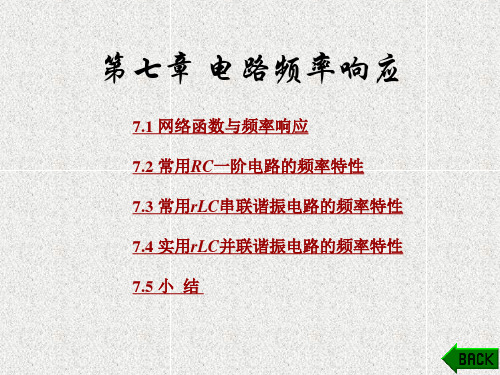
.
H3
(
j
)
U 2 Is
(7.1-4)
若以I2为响应相量,则N
H4 ( j)
I2 Is
(7.1-5)
7.1.2
纯阻网络的网络函数是与频率无关的,这类网络的频率特 性是不需要研究的。研究含有动态元件的网络频率特性才是有 意义的。
一般情况下,含动态元件电路的网络函数H(jω)是频率的
复函数,将它写为指数表示形式,有
图 7.2-3 例7.2-1使用电路
例 7.2-1 如图7.2-3所示由电阻、电容构成的一阶低通网
络,其输出端接负载电阻RL。试分析其频率特性(绘出幅频特 性、相频特性), 并求出截止角频率。
解 以U.1作输入相量,U. 2作输出相量,则网络函数为
H ( j)
UU12
RL
1
jC
RL
1
jC
R
RL
H ( j)def | H ( j) | 1 1 j c
(7.2-17)
式中,|H(j∞)|=|H(jω)|ω=∞, 它是与网络的结构和元件参数
有关的常数。
图 7.2-8 某晶体管放大器的等效电路
例 7.2-3 图7.2-8为某晶体管放大器的低频等效电路。 图中,
. Ui
为放大器的输入信号
如果用分贝为单位表示网络的幅频特性,
| H(j) | def 20lg | H(j) | dB
(7.2-6)
也就是说,对|H(jω)|取以10为底的对数并乘以20,就得到 了网络函数幅值的分贝数。 当ω=ωc时,
20lg | H(jc ) | 20lg0.707 3dB
所以又称ωc为3分贝角频率。在这一角频率上,输出电压与它
Protel 99 SE实用教程 第7章 元器件布局

7.1 电路板设计的基本流程
3.规划电路板 规划电路板包括以下内容。 (1)电路板的选型,选择单面板、双面板或者多面板。 (2)确定电路板的外形,包括设置电路板的形状、电气边界和物理边界等参数。 (3)确定电路板与外界的接口形式,选择具体接插件的封装形式及确定接插件的安装位置和电路板的 安装方式等。 从设计的并行性角度考虑,电路板的规划工作有一部分应当放在原理图绘制之前,比如电路板类型的选 择、电路板的接插件和安装形式等。在电路板的设计过程中,千万不能忽视这一步工作,否则有的后续 工作将没法进行。
7.2 设置电路板类型
2.设置工作层面的显示/隐藏属性 下面介绍工作层面的显示/隐藏属性的设置。
(1)执行菜单命令【Design】/【Options…】,打开【Document Option】(文档参数)设置对话 框,然后单击【Layers】选项卡,即可打开工作层面显示/隐藏属性设置对话框,如图7-4所示。
7.5.1 载入元器件封装库
在Protel 99 SE中,常用的元器件封装库主要包括以下几个元器件封装库。 (1)Advpcb.Ddb。 (2)General IC.Ddb。 (3)Miscellaneous.Ddb。 在这些常用的元器件封装库中,一般的元器件封装都能找到。上述元器件封装库位于系统安 装目录“…\Design Explorer 99 SE\Library\Pcb\Generic Footprints\...”下。 在PCB编辑器中载入元器件封装库的方法与在原理图编辑器中载入原理图库的方法完全相同。 下面简单介绍一下PCB元器件封装库的载入方法。
7.6.1 元器件布局基础知识
在进行元器件布局之前,先介绍一些元器件布局的基础知识。 1.元器件布局的方法 元器件布局的方法主要包括以下3种。 (1)自动布局方法。
第七章 访谈法
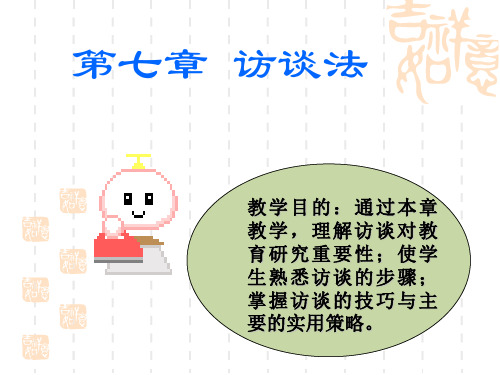
▪ 上例中,为了不占用他们过多的时间,也为了试 图给他们一种比较安全的感觉,我多数是利用中 午12点半以后的时间,在我的办公室或某个教研 室开始我与他们的谈话。
▪ 这个时间不仅不太占用他们的学习时间,而且系 里几乎没有什么人,办公室很安静,我每次都把 门插上,防止外界的干扰。
5、试谈与修改提纲
▪ 确定访谈提纲后,正式进行访谈之前一般要安排 一次试谈。
▪ 通过集体座谈的方式进行调查,可以集思广益, 互相启发,互相探讨,而且能在较短的时间里收 集到较广泛和全面的信息。
6.一次访谈 ▪ 是指在同一时段对某一研究问题进行的一次性收
集资料的访谈。
▪ 这种研究需要抽取一定的样本,被访者有一定的 数量,访谈内容是以收集事实性材料为主,研究 一次性完成。
7.多次性访谈 ▪ 又称重复性访谈,它是指多次收集固定研究对象
▪ 半开放型访谈兼有二者的优点,它既可以避免结构性访 谈缺乏灵活性,难以对问题作深入的探讨等局限,也可 以避免非结构性访谈的费时、费力,难以作定量分析等 缺陷。
▪ 但它性质上属于开放型访谈,它并没有追求标准化的结 构和获得资料的统计分析。
4.个别访谈 ▪ 指访谈员对每一个被访者逐一进行的单独访谈。
2.与问卷调查法比较 ▪ 问卷调查使用的是研究者自己的语言,提出的是研究
者自己所关心的问题,调查的问题和答案都是研究者 按自己的意图设计好的。问卷的结构使问卷调查受到 限制,对方无法在这个结构之外用自己的语言发表自 己的看法,提出自己的问题。
▪ 访谈中,受访者可以使用自己的语言和概念表达自己 的观点,谈论自己所关心的问题,对自己的生活经历 进行细致的描述,对它们的意义作出自己的解释。质 的研究最突出的特点和最重要的功能是意义的解释性 理解,访谈通过直接的语言交流所实现的正是这种功 能、特点,所以被认为是质的研究最重要的资料收集 方式。
第7章实用类
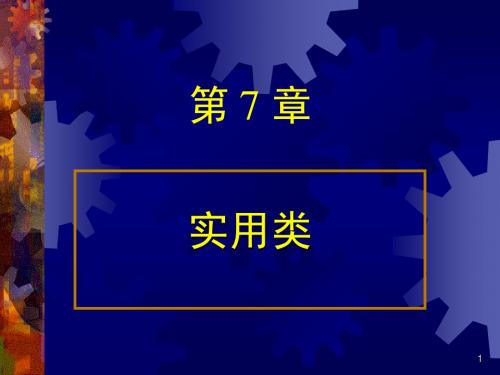
C1:Centre:(20,20) ;Radius:30 import java.io.*; public class TestClass C2:Centre:(20,20) ;Radius:30 { public static void main(String[] args) throws CloneNotSupportedException C1:Centre:(60,70) ;Radius:30 { Circle c1=new Circle(new Point(20,20),30); C2:Centre:(60,70) ;Radius:30 Circle c2=(Circle)c1.clone(); System.out.println("C1:"+c1); System.out.println("C2:"+c2); c2.setCentre(60,70); System.out.println("C1:"+c1); System.out.println("C2:"+c2); } } c1 centre radius (30) ......
17
Class 类
类是用于管理类信息的类。 在Java中,Class类是用于管理类信息的类。 中 类是用于管理类信息的类 常用的成员方法有: 常用的成员方法有: static Class forName(String className) String getName( ) Class getSuperclass( ) boolean isInterface( ) String toString( )
(20,20) c2 centre radius (30)
PS 第7章_路径和矢量图形
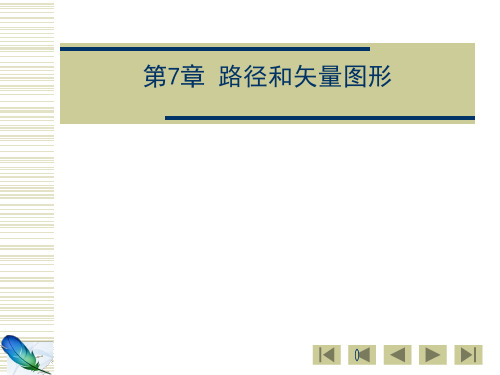
PhotoShopCS2平面设计实用教程
7.2.1钢笔工具
(8)样式:用于形状图层添加系统预设的样式。 (9)颜色:颜色单击颜色色块弹出“拾色器”对话框,用来选择填充颜色。
2.使用钢笔工具绘制路径
(1)绘制直线路径 使用单击鼠标的方式产生直线锚点,从而绘制直线路径。具体操作如下: ①选择钢笔工具,确认选中 ,确认钢笔几何选项未勾选“橡皮带”复选框。 ②将钢笔指针定位在起点并单击鼠标,形成第一个锚点。 ③将钢笔指针移动到终点位置处单击鼠标,两个锚点之间即可创建一条直线,如图7-7所示。 ④如果要创建封闭式直线路径,在结束时将鼠标指针移到起始锚点上,当鼠标指针变为 形 状时,单击鼠标,即可完成创建封闭式直线路径的绘制,如图7-8所示。
图7-6 钢笔工具选项栏2
PhotoShopCS2平面设计实用教程
7.2.1钢笔工具
钢笔工具选项栏各选项参数含义如下。 (1)形状图层按钮 :按下此按钮,选项栏如图7-5所示,表示当前正在创建或编辑图形或 形状图层。在绘制路径中会自动填充前景色或一种选定的图层样式图案,每绘制一个图 像就创建一个图层,绘制后的图像不能用油漆桶工具填充颜色和图案。 (2)路径按钮 :按下此按钮,选项栏如图7-6所示,表示当前正在绘制路径,而且不能自 动进行填充。 (3)路径工具按钮 :选择当前使用的是钢笔工具或是自由钢笔工具。 (4)形状按钮 :分别用于绘制矩形、圆角矩形、椭圆、多边形、直线、自定义 形状图形形状或路径。 (5)几何选项按钮 :选择不同的工具选项按钮,单击此按钮,弹出不同的调板,以控制不 同的几何选项。 (6)自动添加/删除:选中此复选框,使用钢笔工具不仅可以绘制路径,钢笔工具还具备自 动添加/删除的功能,可以在原路径上添加或删除锚点。当移动到原路径曲线上时,在原 指针右下方增加一个“+”号,单击路径曲线,即可在单击处增加一个锚点;当移动到原 路径锚点上时,在原指针右下方增加一个“-”号,单击锚点,即可删除该锚点。 (7)多路径设置按钮:用来决定绘制路径且路径重叠时采取何种处理方式。
7 第七章数据分析-数据挖掘算法与应用(Python实现)-孙家泽-清华大学出版社

⑥ 撰写报告
西安邮电大学
1.1 背景知识
4 Python
Python语言的特点: Python是一门动态解释性的强类型定义语言,具有高
效的高级数据结构和简单而有效的面向对象编程的特性。 Python具有极强的可移植性、可扩展性和可嵌入性,
具有丰富且强大的库。它常被昵称为“胶水语言”,能 够把用其它语言制作的各种模块(尤其是C/C++)很轻松 地联结在一起。
机数生成的内置函数。
西安邮电大学
2.1 预备Βιβλιοθήκη 识1 NumpyNumPy是一个Python的第三方库,它功能强大,是一个由 多维数组对象和用于处理数组的例程集合组成的库。NumPy主 要用于数学、科学计算。现在一般会通过NumPy、Scipy和 Matplotlib结合来替代Matlab,是一个流行的技术计算平台。
创建等差数列数组
西安邮电大学
2.1 预备知识
2 Numpy常用方法
西安邮电大学
2.1 预备知识
3 Numpy矢量化计算
西安邮电大学
2.1 预备知识
3 Numpy的矢量化计算
西安邮电大学
1.2 预备知识
4 Numpy数组的索引和切片
方式 ndarray[n] ndarray[n:m] ndarray[:] ndarray[n:] ndarray[:n] ndarray[n,m]
西安邮电大学
1.1 背景知识
3 数据分析
数据分析的一般步骤: ③ 数据处理 原始数据必须经过处理或组织分析。通常是将结 构化数据放入表格的行和列中供进一步分析。 其中数据处理的常用方法有:数据清洗、数据加工、 数据计算等。
西安邮电大学
高考语文-实用类,论述类,文学类文本考点大汇总

高考语文-实用类/论述类/文学类文本考点大汇总实用类文本阅读知识储备一.传记1.传记的阅读方法(1)阅读传记作品必须懂得传记作品与其他文学作品的区别。
传记属于纪实性作品,纪实性要求传记记述的事实是客观存在的、准确的、真实的。
但历史的真实,只能是相对的真实,任何已经成为过去的历史是不可能全面复现的,任何对历史的叙述,也只能是相对真实的描述。
因此,传记允许作者对个别细节、某些场景进行符合时代环境的合理的有限度的想象,以便丰富、生动地描绘人物,凸现人物特性。
了解了传记作品的这些特点,就可以在学习的过程中欣赏、品味传记作品真实性与文学性相结合、哲理性与形象性相结合、思辨性与审美性相结合所产生的魅力,赏析传记中的想象艺术,多角度地培养鉴赏能力。
(2)阅读传记作品必须联系传主生活的时代背景和社会环境。
一个人的个性、思想的形成必定会受到所处的特定时代及其成长环境等外因的影响,了解这些重要事实可以使我们对传主成长的各种因素作出符合实际的分析,以便更立体地了解人物,对其思想、品格及功过作出客观公允的评价。
(3)阅读传记作品必须认识到传主的成长经历并感悟传主的心路历程。
只有深刻地认识传主的成长经历并感悟其心路历程,注重分析传主的先天察赋和后天环境、志向和命运、奋斗和机遇、挫折和成功、事业和爱情等诸多因素对其人生发展的重要意义,才能在评价传主的思想、感情、品格、气质、成就等方面的同时,从中汲取精神养料,获得有益的启示,丰富自己的人生经验,形成主动规划人生的意识和能力。
(4)阅读传记作品还要关注传主具有典型意义的事件和细节。
典型事件往往是传主一生的关键所在,能能反映他一生中的主要功过,而且可以显示有关的历史进程及特点,有科于读者把握文章的重点,理清其人生发展的脉络;富有特性的细节描写犹如人体之血肉,能使传主的形象更加丰满,能帮助读者更准确地了解传主的性格、理想。
同时,关注这些还可以引发读者的思索,使之从中获得更多的人生教益。
电气工程CAD实用教程第7章 建筑电气平面设计
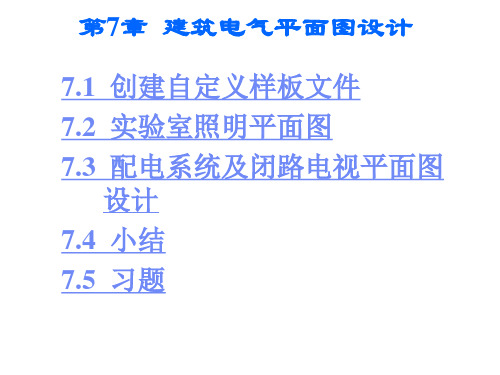
图7-6 创建新标注样式后的【标注样式管理器】对话框
7.1.4 保存为自定义样本文件
1.单击 按钮,选择【另存为】命令,弹出【图 形另存为】对话框,在【文件名】栏中输入 “建筑电气平面图用样板”,在【文件类型】 下拉列表中选择【AutoCAD图形样板 (*.dwt)】,如图7-7所示。 2.单击 按钮,弹出【样板选项】对话框, 在【测量单位】下拉列表中选择【公制】, 在【新图层通知】分组框中选择【将所有图 层另存为未协调】单选项,如图7-8所示。
7.1 创建自定义样板文件
1.
2.
3.
4.
7.1.1 7.1.2 7.1.3 7.1.4
设置图层 设置文字样式 设置标注样式 保存为自定义样本文件
7.1 创建自定义样板文件
用AutoCAD绘图时,为当前图形设置的图层、 文字样式、标注样式等仅存储在当前图纸文件里, 对新建的文件不起作用,还要重新设置。若所要 绘制的批量图形均可以采用相同的图层设置、文 字样式、标注样式及表格样式,则用户可在绘制 图形之前事先设置好图层、文字样式、标注样式 及其他希望保存的选项,再将该文件另存为 “AutoCAD图形样板(.dwt)”,下次使用时直 接选择该样板文件即可。
(7)双击图7-15和7-16所示的符号A,将其激活 并修改文字,然后移动图7-16所示的图形至 图7-17的适当位置,结果如图7-17所示。其 中,符号A所在圆的圆心距符号1所在圆的圆 心的相对位置为(-14.5,14.5)。
(8)绘制矩形并偏移。矩形的绘制起点距基线1 与基线D交点的偏移值为(-1.5,1.5),尺寸 为148×96,如图7-18所示。然后将矩形向里 偏移3,结果如图7-19所示。
图7-2 【文字样式】对话框
中职教育-《89C51单片机实用教程》课件:第7章 89C51单片机中断系统和定时器(4).ppt
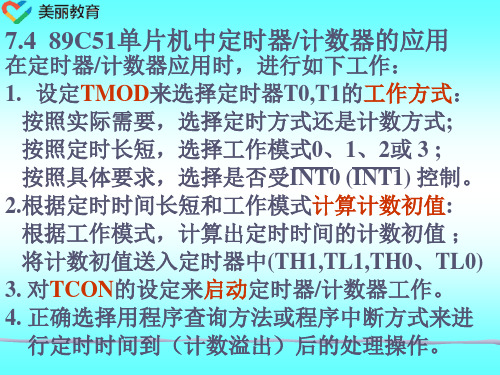
SJMP LOOP
END
例7.9 工作模式1的应用 利用定时器 T1 工作模式1, 在引脚 P1.1 上输出
7.4 89C51单片机中定时器/计数器的应用
在定时器/计数器应用时,进行如下工作: 1. 设定TMOD来选择定时器T0,T1的工作方式:
按照实际需要,选择定时方式还是计数方式; 按照定时长短,选择工作模式0、1、2或 3 ; 按照具体要求,选择是否受INT0 (INT1) 控制。 2.根据定时时间长短和工作模式计算计数初值: 根据工作模式,计算出定时时间的计数初值 ;
将计数初值送入定时器中(TH1,TL1,TH0、TL0) 3. 对TCON的设定来启动定时器/计数器工作。 4. 正确选择用程序查询方法或程序中断方式来进
行定时时间到(计数溢出)后的处理操作。
7.4.1 定时器工作方式的设置和计数初值计算
对定时器的工作模式寄存器TMOD进行设定:
l. 定时方式和计数方式选择。
解: ⑴ 如图在引脚 P1.0 上输出周期为 2ms 连续方波,
需要定时器 T0 产生 1ms 的定时。 每隔1ms时间 P1.0 引脚的输出取反即可。
解:
⑵. T0工作于模式0,计数器为13位的加1计数器, fosc=6MHz,则1个振荡周期为1/6μs 定时时间为1ms,根据公式: t =(213-T0初值)×振荡周期×12 1×10-3=(213-T0初值) ×( 1/6×10-6 ) ×12 T0初值= 7692 = 1111000001100B
多为:213=8192个。
例7.5 定时器T0工作在模式0, CPU主频 fosc=6MHz 定时1ms, T0的初值为多少?计算最长定时时间?
解:T0工作于模式0时, 为13位的加1计数器 ①. 定时1ms,根据公式:
《直播营销话术》PPT 第7章

7.2.2 服装类单品直播营销话术
15
4.突出价格优势
主播通常会先说出对比的价格,然后说出直播间的价格,突出优惠力度。 此外,主播还会介绍一些清洗服装的小知识,以打消用户下单的顾虑。
5.运用名人效应
许多人有模仿心理,尤其愿意模仿名人的穿搭,他们希望通过这种方式来拉近自己与名人之间 的距离。因此,“名人同款”成为很多人选择服装时的一个重要依据。
① 金属拉链,顺滑耐磨,做工精细,上面的刻字清晰可见,非常 有质感 ② 双向拉链设计,使用方便,活动时可拉胯下方拉链,减少束缚 感
7.1.2 服饰类直播营销常用话术
8
服饰部位/工艺 纽扣/钉扣 面料 制作工艺
讲解话术模版
① 金属钉扣更加耐用,也更加凸显衣服的档次 ② 做旧合金金属纽扣,与牛仔裤的质感完美契合 ③ 高档定做纽扣,彰显衣服的整体品质 ④ 纽扣的款式、材质完美贴合针织衫的风格,让衣服显得更加精 致、美观
① 袖口采用包边设计,能有效防止袖口毛边脱线 ② 袖口采用双线绗缝设计,美观大方 ③ 袖口采用针织手法,收口效果好,穿着舒适 ④ 袖子内设有可抽拉绳,绳子可拉出来系在袖子上,将长袖变成 短袖,让你实现一衣多穿
① 腰部裁剪修身,凸显身体曲线 ② 腰部采用抽绳设计,可任意调节松紧,凸显身材 ③ 精致的金属腰带扣,时尚耐用
7.1.2 服饰类直播营销常用话术
7
服饰部位/工艺 印花
袖口 腰部 拉链
讲解话术模版
① 印花设计,做工精致,个性时尚 ② 胸前个性印花采用特殊工艺制作,形象自然,且不易洗掉 ③ 印花图案采用线描手法制作,凸显手绘效果,时尚可爱 ④ 印花色彩清晰饱满,采用高级发泡乳胶印制,无异味,不龟裂, 印花微微凸出,更具立体感
主播在介绍商品时还 要强调质量保障,如 果一味地说“低价”, 也会引起用户对商品 质量的质疑。
实用类文本阅读-科普文章的特色考法(教案)-现代文阅读-高考语文一轮复习(全国通用)
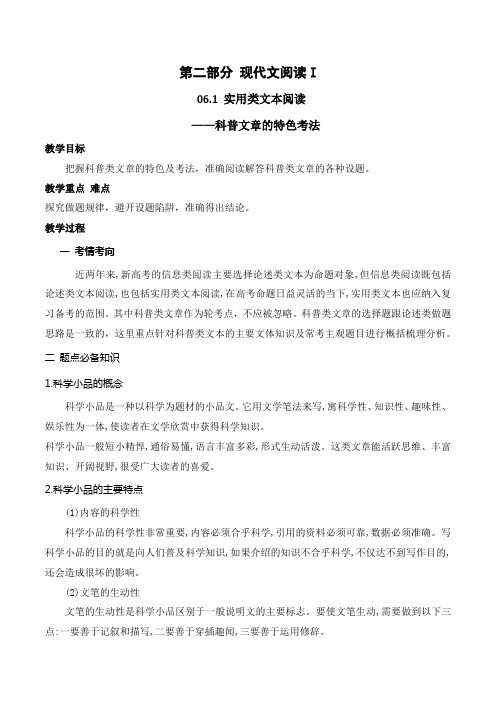
第二部分现代文阅读I06.1 实用类文本阅读——科普文章的特色考法教学目标把握科普类文章的特色及考法,准确阅读解答科普类文章的各种设题。
教学重点难点探究做题规律,避开设题陷阱,准确得出结论。
教学过程一考情考向近两年来,新高考的信息类阅读主要选择论述类文本为命题对象,但信息类阅读既包括论述类文本阅读,也包括实用类文本阅读,在高考命题日益灵活的当下,实用类文本也应纳入复习备考的范围。
其中科普类文章作为轮考点,不应被忽略。
科普类文章的选择题跟论述类做题思路是一致的,这里重点针对科普类文本的主要文体知识及常考主观题目进行概括梳理分析。
二题点必备知识1.科学小品的概念科学小品是一种以科学为题材的小品文。
它用文学笔法来写,寓科学性、知识性、趣味性、娱乐性为一体,使读者在文学欣赏中获得科学知识。
科学小品一般短小精悍,通俗易懂,语言丰富多彩,形式生动活泼。
这类文章能活跃思维、丰富知识、开阔视野,很受广大读者的喜爱。
2.科学小品的主要特点(1)内容的科学性科学小品的科学性非常重要,内容必须合乎科学,引用的资料必须可靠,数据必须准确。
写科学小品的目的就是向人们普及科学知识,如果介绍的知识不合乎科学,不仅达不到写作目的,还会造成很坏的影响。
(2)文笔的生动性文笔的生动性是科学小品区别于一般说明文的主要标志。
要使文笔生动,需要做到以下三点:一要善于记叙和描写,二要善于穿插趣闻,三要善于运用修辞。
(3)内容的通俗性科学小品不是为专业科研服务的,它以普及科学知识为己任,所以它必须深入浅出、通俗易懂地解释、介绍、表现科学内容。
(二)科普文章的结构特点科普文章的结构一般为“倒金字塔”:首先引出话题,介绍新工艺、新技术、新见解、新成果或新问题、新挑战,然后从不同角度具体介绍这个“新”的形态、构造、成因、功用、原理、演变、发展、现状、评价等。
(三)科普文章的说明顺序一般有空间顺序、时间顺序和逻辑顺序(原因到结果、主要到次要、整体到部分、概括到具体、现象到本质、特点到用途、总分总等)。
MATLAB实用教程(第2版)第七章数学计算
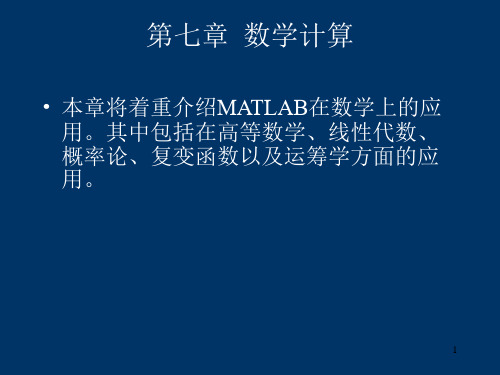
● [R,p]=chol(X),X是正定矩阵时,返回的矩阵R是上三 角矩阵,而且满足等式 ,同时返回参数p=0;X不是正定矩阵 时,返回的参数p是正整数, 是三角矩阵,且矩阵阶数是p-1, 并且满足等式 。
例7.8 将对称正定矩阵
23
例7.9 对矩阵
进行LU分解。
(1)新建一个M文件;
(2)在文本编辑器中键入如下内容:
A=[-1 8 -5;9 -1 2;2 -5 7]; [Ll,Ul]=lu(A) Al=Ll*Ul x=inv(A) xl=inv(Ul)*(Ll) d=det(A) dl=det(Ll)*det(Ul)
(3)保存文件,文件名为“exam0709.m”; 运行脚本可得到结果下:
• 例7.1 分别求取函数 、 、 、 和 的极限。 在命令窗口输入的具体代码如下:
syms x a t h;
limit(sin(x)/x) limit((x-2)/(x^2-4),2) limit((1+2*t/x)^(3*x),x,inf) limit(1/x,x,0,'right') limit(1/x,x,0,'left')
进行Cholesky分解。
20
(1)新建一个M文件; (2)在文本编辑器中键入如下内容:
X=[1 1 1 1 1;1 2 3 4 5;1 3 6 10 15;1 4 10 12 35;1 5 15 35 70]; R=chol(X) C=transpose(R)*R
(3)保存文件,文件名为“exam0708.m”; 运行脚本后可得到如下结果:
18
(3)保存文件,文件名为“exam0707.m”; 运行脚本后可得到如下结果:
会计信息化实用教程(用友T3会计信息化专版)-第七章-固定资产管理
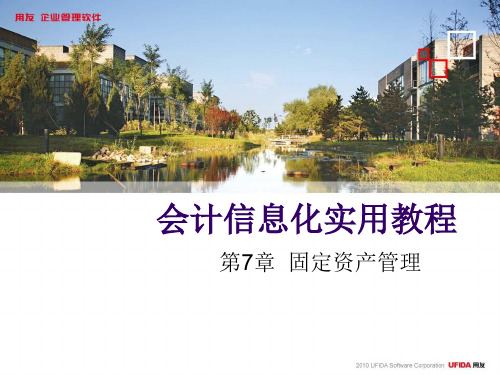
7.2.3 输入期初固定资产卡片
固定资产卡片是固定资产核算和管理的 基础依据.为保持历史资料的连续性, 必须将建账日期以前的数据录入到系统 中.原始卡片的录入不限制必须在第一 个期间结账前,任何时候都可以录入原 始卡片.原始卡片上所记录的资产的开 始使用日期一定小于固定资产系统的启 用日期.
7.2.3 输入期初固定资产卡片
1.约定与说明 (1)序时管理原则 (2)固定资产变动后的折旧计算和分配汇总原则 2.启用月份 如果需要向总账系统传递凭证,那么固定资产的启用月份不得在总账系统的启用 月份之后.启用日期确定之后,在该日期前的所有固定资产都将作为期初数据, 从启用月份开始计提折旧. 3.折旧信息 设定本企业的折旧方案,即确定是否提折旧,采用什么方法提折旧,多长时间进 行折旧汇总分配. 4.编码方式 按照编码管理对象是计算机业务处理的基本特征.在固定资产系统中需要对每一 项资产所属的资产类别及资产本身进行编码管理,此处是指设定编码的原则. 5.账务接口 如果固定资产和总账系统集成使用总账系统中管理"固定资产"和"累计折旧" 科目的总账,固定资产系统管理每一项固定资产和折旧计算的详细情况,但两者 应该存在相等关系. 6.其他参数 在固定资产初始化向导中完成以上参数设置后,还有另外进行一些参数的补充设 置,例如业务发生后是否立即进行制单处理,固定资产和累计折旧的入账科目设 定等.
7.2.1 固定资产参数设置
7.2.2 设置基础数据
1.资产类别设置 固定资产的种类繁多,规格不一.要强化固定 资产管理,及时准确作好固定资产核算,必须 科学地建立固定资产的分类,为核算和统计管 理提供依据.企业可根据自身的特点和管理要 求,确定一个较为合理的资产分类方法. 2.部门设置 在部门设置中,可对单位的各部门进行设置, 以便确定资产的归属.在用友通控制台的基础 设置中设置的部门信息是共享的.
第七章-堰流PPT课件

3
Qmcb 2gH2
mc
(0.4050.00270.03Bb)
H
H
[(10.55 b2)( H )2] B Hp
-
16
4、注意要点
1)H>3m,否则因表面张 力作用将发生贴附溢流,
如右图。
a
2)水舌下面的空间应与大气
相通,否则水舌形成局部真
空,如图a,影响出流稳定。
通常应在水舌下面的侧壁上
b
设置通气管。如图b
曲线形 折线形
有坎 无坎
-
4
1、薄壁堰
δ/H<0.67
此时水舌不受堰壁厚度的影 响,水流呈自由下落曲线。
堰顶水头H 堰高P1
堰宽b 堰高P2
堰顶厚度δ
据堰上形状
矩形堰 三角堰 梯形堰
-
5
பைடு நூலகம்
2、实用断面堰
0.67< H <2.5
此时δ影响水舌的形状。过堰 水流开始受到堰顶的约束,但水流 基本上还是在重力作用下的自由下 落曲线。
第七章 堰流
§7-1 堰流的定义及分类 §7-2 堰流基本公式 §7-3 薄壁堰 §7-4 宽顶堰
-
1
§7-1 堰流的定义及分类
一、定义:
1、堰: 2、堰流:
明渠水流中的局部障壁称为堰。
无压缓流流经堰顶时的局部 水力现象称为堰流 。
堰 流 特 点
⑴ 上游发生水位壅高,然后水面降落 ⑵ 水力计算仅考虑局部水头损失,沿
1)当堰口形状为等腰三角形时(θ=60°):
Q=1.343H2.47 m3/s
适用条件:H=0.05~0.25m
2) 当堰口形状为θ=90°时:
Q=0.0154 H2.47 m3/s
- 1、下载文档前请自行甄别文档内容的完整性,平台不提供额外的编辑、内容补充、找答案等附加服务。
- 2、"仅部分预览"的文档,不可在线预览部分如存在完整性等问题,可反馈申请退款(可完整预览的文档不适用该条件!)。
- 3、如文档侵犯您的权益,请联系客服反馈,我们会尽快为您处理(人工客服工作时间:9:00-18:30)。
7.1 Date类
2.格式化时间 Date对象表示时间的默认顺序是:星期、月、日、小时、 分、秒、年,如 Sat Apr 28 21:59:38 CST 2001 可以使用DateFormat的子类SimpleDateFormat来实现日 期的格式化。SimpleDateFormat有一个常用构造方法: public SimpleDateFormat(String pattern) 该构造方法可以用参数pattern指定的格式创建一个对 象sdf,sdf调用 public String format(Date date) 方 法格式化时间参数date指定的时间对象,format方法将 根据创建sdf对象时所使用的参数pattern返回一个字符 串对象 formatTime: String formatTime=sdf.format(new Date());
5
public public public public public
2016/6/4
7.4 Collection-JAVA集合专题
Separating Collection Interfaces and Implementation
As is common for modern data structure libraries, the Java collection library separates interfaces and implementations. Let us look at that separation with a familiar data structure, the queue.
2016/6/4 11
7.4 Collection-JAVA集合专题
Separating Collection Interfaces and Implementation Each implementation can be expressed by a class that implements the Queue interface:
2016/6/4
13
7.4 Collection-JAVA集合专题
Separating Collection Interfaces and Implementation
Why would you choose one implementation over another? The interface says nothing about the efficiency of the implementation.
class CircularArrayQueue<E> implements Queue<E>{ CircularArrayQueue(int capacity) { . . . } public void add(E element) { . . . } public E remove() { . . . } public int size() { . . . } private E[] elements; private int head; private int tail; }
2016/6/4 6
7.4 Collection-JAVA集合专题
Separating Collection Interfaces and Implementation
A queue interface specifies that you can add elements at the tail end of the queue, remove them at the head, and find out how many elements are in the queue. You use a queue when you need to collect objects and retrieve them in a "first in, first out" fashion.
第7章 常用实用类
Date类和Calendar类 Math类与BigInteger类 LinkedList<E>泛型类 HashSet<E>泛型类 TreeSet<E>泛型类 HashMap<K,V>泛型类 TreeMap<K,V>泛型类 Stack<E>泛型类
2016/6/4
1
7.1 Date类
2016/6/4 12
7.4 Collection-JAVA集合专题
Separating Collection Interfaces and Implementation
Queue<Customer> expressLane = new CircularArrayQueue<Customer>(100); expressLane.add(new Customer("Harry")); Queue<Customer> expressLane = new LinkedListQueue<Customer>(); expressLane.add(new Customer("Harry"));
2016/6/4
14
7.4 Collection-JAVA集合专题
Separating Collection Interfaces and Implementation
A circular array is somewhat more efficient than a linked list, so it is generally preferable. However, as usual, there is a price to pay. The circular array is a bounded collection, it has a finite capacity. If you don't have an upper limit on the number of objects that your program will collect, you may be better off with a linked list implementation after all.
1.Date对象
◆Date类在java.util包中。使用Date类的无参数构造方法创建 的对象可以获取本地当前时间。 ◆ 用Date的构造方法Date(long time)创建的Date对象表示相对 1970年1月1日0点(GMT)的时间,如参数time取值60×60×1000 秒,表示Thu Jan 01 01:00:00 GMT 1970 。 ◆ System类的静态方法 public long currentTimeMillis()可 以获取系统当前时间,这个时间是从1970年1月1日0点(GMT)到 目前时刻所走过的毫秒数(这是一个不小的数)。 可以根据currentTimeMillis()方法得到的数字,用Date的构 造方法Date(long time)来创建一个本地日期的Date对象。
2016/6/4 7
7.4 Collection-JAVA集合专题
Separating Collection Interfaces and Implementation
2016/6/4
8
7.4 Collection-JAVA集合专题
Separating Collection Interfaces and Implementation
2016/6/4 15
7.4 Collection-JAVA集合专题
Separating Collection Interfaces and Implementation
When you study the API documentation, you will find another set of classes whose name begins with Abstract, such as AbstractQueue. These classes are intended for library implementors.
◆public final void set(int year,int month,int date) ◆public final void set(int year,int month,int date,int hour,int minute) ◆public final void set(int year,int month,int date,int hour,int minute,int second)
class LinkedListQueue <E> implements Queue<E>{ LinkedListQueue() { . . . } public void add(E element) { . . . } public E remove() { . . . } public int size() { . . . } private E[] elements; private Link head; private Link tail; }
2016/6/4 3
7.2
Calendar类
Calendar 类 在 java.util 包 中 。 Calendar 类 的 static 方 法 getInstance()可以初始化一个日历对象,如 Calendar calendar= Calendar.getInstance(); calendar对象设置时间方法:
2016/6/4 9
7.4 Collection-JAVA集合专题
Separating Collection Interfaces and Implementation
